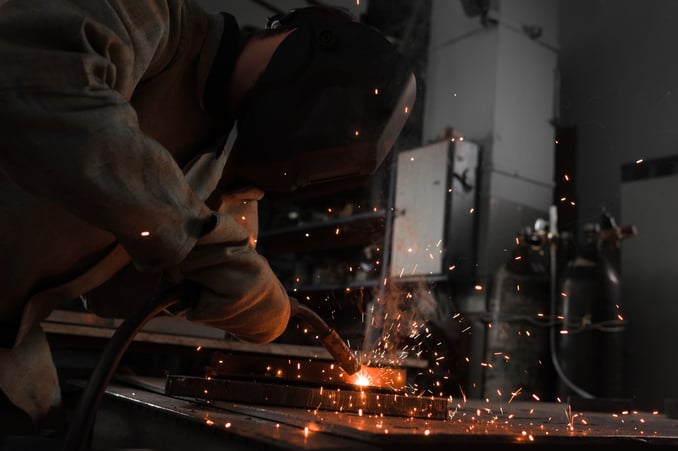Manufacturers are feeling the pinch as they face various challenges in 2023, including rising costs, labor woes and inflationary pressure. This seesaw of manufacturing industry issues has continued into 2023, quashing hopes for growth in this vital economic hub.
This year’s Make UK Executive Survey 2023 demonstrates the short-term challenges hampering manufacturers are stifling labour shortages, the rising cost of doing business, and ongoing supply chain disruption. UK GDP forecasts suggest that the UK economy will contract in 2023 by around 1.4%, with Make UK expecting a 3.2% reduction in output for the manufacturing sector when compared to the previous year.
"Many organizations are already demonstrating innovative thinking, adaptability and leadership. Those manufacturers are breaking new ground by exploring new ways to stand out in their market, while also focusing on keeping costs low. Funding upskilling and retraining programmes for staff, helping them develop new skills and add value to their sector. Using energy efficiency measures, like the adoption of green technology, as a means of reducing expenditure across the value chain. And staying on top of working capital despite the challenge of supply chains lengthening."
Challenges for manufacturers
The main challenges facing manufacturers today are:
- Reducing costs
- Remaining competitive
To remain competitive in this ever-changing landscape, manufacturers must find ways to manage their costs without compromising on quality or customer service.
1. Keeping costs low
Many businesses are altering their business practices to try and reduce their expenditure over the next year as energy, transport and employment costs continue to climb. Unsurprisingly the highest cost manufacturers expect to face next year is for energy with some organizations planning their own on-site electricity generation to ensure responsible and sustained growth in 2023.
- Reducing labor costs

Since labor is one of the biggest expenses for any manufacturer, it’s important to look for ways to reduce it. One way is through automation. Automation not only helps reduce manual labor costs but also helps increase efficiency and accuracy. Automation tools can be expensive at first, but they quickly pay for themselves by reducing errors and increasing productivity in the long run. Additionally, automation is scalable and can be tailored to meet specific production needs as they change over time.
- Maximizing materials
Another way to manage costs is by making sure that all materials are used efficiently and effectively. This means minimizing waste as much as possible by finding ways to use every scrap of material available and reusing what you can. It also means using high-quality materials that will last longer and require less maintenance or replacement down the road. Finally, it means making sure that all materials are stored securely so they don’t become damaged or spoiled before their time.
- Optimizing processes
Manufacturers should also look for ways to optimize their processes in order to reduce waste and increase efficiency. This could mean streamlining communication between departments or simplifying inventory management systems so that everything runs more smoothly overall. Whatever changes are implemented should be tested thoroughly before being rolled out across the board in order to ensure maximum performance with minimal disruption.
2. Remaining competitive
A big risk to manufacturers’ competitiveness in 2023 is the increasing cost of producing goods and services, with shortages of raw materials across the world and ongoing supply chain disruptions being cited as the main culprits.
Winning manufacturers are recognising ESG and decarbonisation as opportunities to create a real competitive advantage — and they are investing in their organization in a way that shapes the industry for the better.
- Being more efficient
Leading manufacturers are proactively exploring new opportunities by investing in the right areas, such as ESG (environmental, social and governance), green tech and decarbonisation with almost half of manufacturers insulating buildings and installing better performing heat systems, and 27% moving to on-site generation. The action to offset the high energy costs is driven by the need for manufacturers to remain globally competitive.
Evidence shows UK manufacturers face higher energy costs in comparison to global counterparts, resulting in an uneven playing field and risking manufacturers becoming globally uncompetitive.
- Innovation and digital transformation
Innovation will continue to be a key challenge for manufacturers over the next few years. Just as consumer pressure is driving the ESG agenda, the need to continue to innovate and gain a competitive edge is driving manufacturers to explore new product development. With technology advancing at an unprecedented rate, organizations must be able to keep up with changing customer expectations by innovating new products or services that meet these needs.
This could include introducing new technologies such as augmented reality or 3D printing into production processes to increase efficiency and reduce waste by automating manual processes, or experimenting with predictive data analytics tools to better understand customer behavior and trends. Data analytics can help identify areas where improvements can be made as well as uncover new opportunities for growth that would otherwise go unnoticed.
- Upskilling or retraining existing staff
One of the biggest challenges faced by manufacturers is finding skilled labour capable of running new technology such as automation and 3D printing safely and efficiently.
 Despite a record level of new hires, job openings in the industry are still hovering near all-time highs, indicating substantial voluntary workforce churn. This prevailing workforce shortage, elevated by supply chain limitations, is reducing operational efficiency and margins.
Despite a record level of new hires, job openings in the industry are still hovering near all-time highs, indicating substantial voluntary workforce churn. This prevailing workforce shortage, elevated by supply chain limitations, is reducing operational efficiency and margins.
Regardless of these challenging conditions, manufacturers are looking to upskill or retrain existing staff in a bid to find the skills they need for their businesses, as well as offer hybrid working and flexibility across operations to meet employee expectations.
Rebooting business confidence
According to PwC, business confidence is critical to growth and investment, but the challenges of 2023 could potentially stifle that confidence.
Manufacturers are expecting tough conditions next year – the vast majority (71%) expect economic conditions in the UK to either significantly or moderately deteriorate, and a further 67% expect global economic conditions to worsen.
Biggest risks to confidence in 2023 identified by manufacturers are:
- Geopoliticial issues
- Rising consumer and producer inflation
- Energy cost uncertainty
- Supply chain disruptions
- Increasing interest rates
In recent years, the need for manufacturers to be resilient, agile and innovative has become the toolkit for survival. However external shocks to the economy can only be
mitigated to a certain degree. The cost of doing business in 2023 could leave some manufacturers in a perilous place.
Productivity and resilience is stronger amongst organizations who are intensely focused on investing in the right areas. Organizations that continually learn, prioritize cost efficiency, reduce their carbon footprint, drive export growth, tackle low investment and solve skills shortages will benefit from a competitive advantage.
As the manufacturing industry evolves, organizations must stay ahead of the curve by preparing themselves for the challenges ahead. By investing in smart solutions that enable them to stay competitive while keeping up with customer demands, manufacturers will be well-positioned for success in 2023 and beyond.


